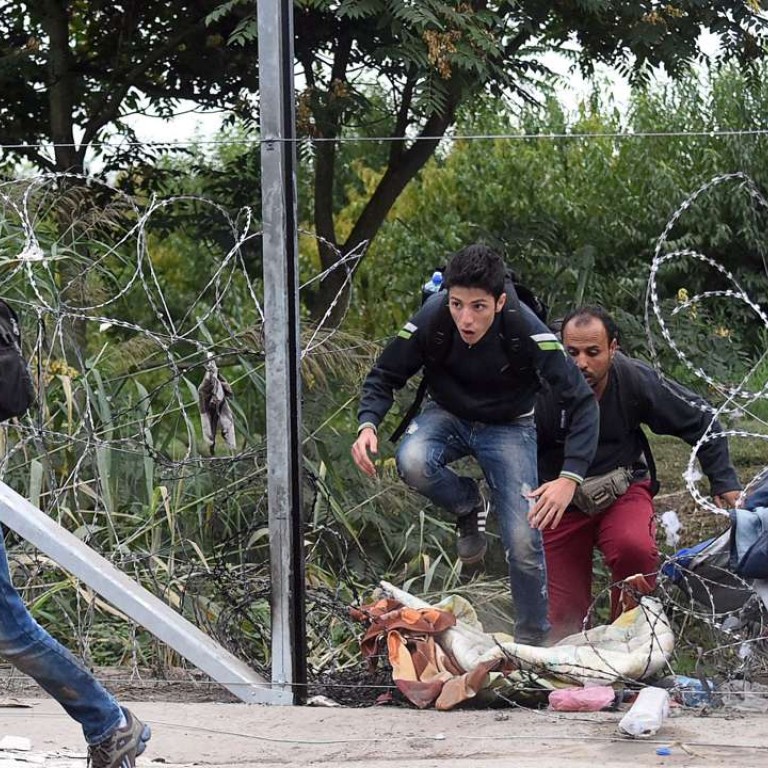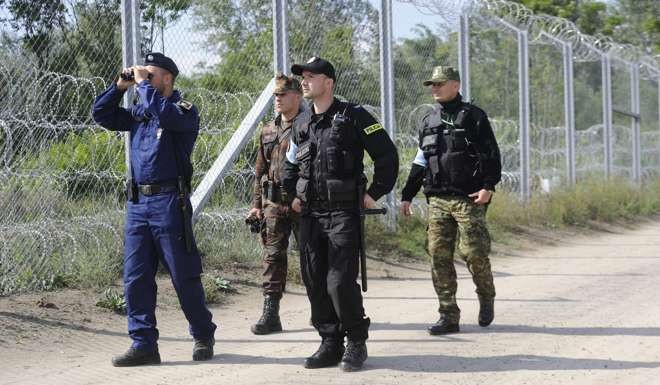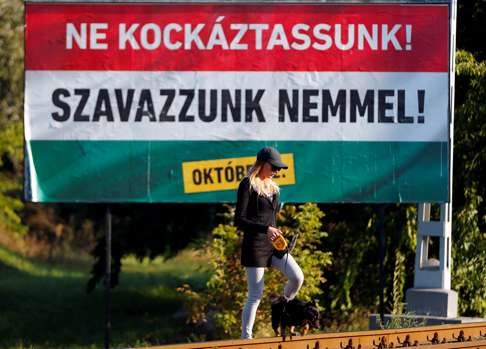
How do you stop migrants? In Hungary, with ‘border hunters’
Prime Minister Viktor Orban, a fan of Donald Trump’s immigration plan, has asked Hungarians to reject quotas for hosting refugees in a referendum Sunday that may solidify his power
During a recruiting fair at a police proving ground here, a gaggle of teenagers ogled a display of machine guns, batons and riot gear. A glossy flier held out the promise of rugged patrols in 4x4s, super-cool body-heat detecting equipment, night-vision goggles and migrant-sniffing dogs.
Because that’s how Hungary’s new “border hunters” roll.
They may as well hang a sign at the border, critics say: Welcome to Hungary - the migrant’s dystopia.
Donald Trump may want a wall, but Hungarian Prime Minister Viktor Orban - a vocal fan of Trump’s immigration plan - has built one. Now, the nation is launching a massive recruitment drive for 3,000 “border hunters.” Their mission: beef up an already formidable migrant blockade, turning Hungary into a global model of how to prevent even the most determined asylum seeker from slipping through.
“Hungary does not need a single migrant for the economy to work or the population to sustain itself or for the country to have a future,” said Orban, who likened migration to “poison”. He added, “Every single migrant poses a public security and terror risk.”

Yet in a country where the Gestapo once hunted Jews and cold war-era secret police ferreted out dissidents, some here say that the government is in danger of instilling a different kind of fear.
Orban’s government is fueling the public rebellion against the mostly Muslim migrants, critics say, by financing a multimillion-euro campaign asking voters to reject EU quotas. Opponents call it the rise of state-sponsored hate speech.
In a widely distributed flier, the campaign is echoing Trump’s claim last year that aggressive Muslim migration has turned some European neighbourhoods into “no-go zones”. In one series of national ads, billboards in cities, towns and villages asked Hungarians, “Did you know?” before answering their own question:
● “Since the beginning of the migration crisis more than 300 people died in terrorist attacks in Europe.”
●“Since the beginning of the migration crisis, harassment against women in Europe increased dramatically.”

[The Orban government] have launched this extremely vile campaign to portray migrants as rapists and terrorists. They have created a great opportunity for racists
Critics concede it is within the limits of freedom of expression for anti-migrant supporters to make such blanket claims. But what is extraordinary, they say, is the zeal with which the government itself has become a mouthpiece for ethnic and religious caricatures.
The Orban government, they argue, is mainstreaming racism.
“They have launched this extremely vile campaign to portray migrants as rapists and terrorists who can only be stopped if we put up walls to protect our Christian identity,” said Marta Pardavi, co-chair of the Hungarian Helsinki Committee. “To them, it doesn’t matter that it’s not true what they’re saying. They have created a great opportunity for racists.”
Europe’s migrant flood of last year has slowed to a trickle, in part because of a tenuous E.U. deal with Turkey as well as a move by Balkan nations to shut their borders.

But hundreds of migrants are still slipping through, and more than 100,000 are stranded in the entry countries of Greece and Italy. All nations in the bloc, E.U. officials say, must share the burden and resettle a certain number of migrants determined by country size, population, economy and other factors.
But Hungary - along with Poland, the Czech Republic and Slovakia - is suing the E.U. to avoid taking in the 1,294 migrants the bloc says it must resettle. Sunday’s referendum is ostensibly to block future quotas. But it has effectively become a referendum on migrants themselves.
Orban last week suggested one solution: setting up a “giant refugee city” in lawless Libya to process asylum seekers.
Balazs Hidveghi, a spokesman for Orban’s Fidesz Party, defended the “no” campaign and the hiring of border hunters, rejecting criticism as political correctness.

A former anti-communist activist turned populist nationalist, Orban last year took heat from his European peers for throwing up a fence to block the path of asylum seekers streaming into Europe from the war-torn Middle East. Yet Hidveghi bragged that, for instance, the leader of Austria - who criticised Orban’s hard-line stance - is out of a job, while Orban is stronger than ever.
“We are setting the agenda,” Hidveghi said.
One thing is relatively clear: Hungary’s migrant blockade seems to be working.
From a peak of more than 13,000 migrants a day, Hungary has more or less snuffed out illegal migration. About 30 legal migrants a day are allowed into transit centres for processing, and even the UN High Commissioner for Refugees (UNHCR) concedes that very few illegal migrants appear to be getting through.
That is partly because since July, Hungarian police and soldiers - about 8,000 of them - have begun “escorting” back behind the fence any migrant found within five miles of Hungary’s side of the border.

Because the fence rests a few feet within Hungarian territory, the government says it is not technically expelling asylum seekers, a violation of international law.
The new border hunters will augment their efforts, officials say, by pairing with more experienced officers to spot migrants from towers and vehicles, track them and ultimately put them back behind the fence.
The UNHCR, however, says the policy appears to violate the Geneva Conventions. In addition, the UNHCR and Doctors Without Borders have documented allegations that the Hungarian police in more than 100 instances used excessive force to return migrants. Some migrants interviewed had showed investigators dog bites, severe bruises and other injuries.
“It is a basic right that if a person wants to ask for asylum, they have the right to cross the border in an irregular manner and make such a request,” said Erno Simon, a senior spokesman for the UNHCR in Hungary.

In early August, according to Amnesty, more than half of the 1,200 asylum seekers residing in Hungary were under official detention. Former detainees reported beatings and threats of violence by Hungarian police and security guards.
Hungarian officials call such claims unfounded. Asked about allegations of mistreatment by migrants, Hidveghi shrugged.
“Migrants have also said they came from Syria and turned out to be terrorists,” he said.

How the migrant issue is playing out within the 28-nation bloc
Asylum seekers in Europe
Eurostat, the EU’s statistical office, says there were 1.25 million first-time asylum applicants in the EU during all of last year and 1.44 million in the 12 months before September 21.
Germany led the EU in 2015 with 441,800 first-time applicants, followed by Hungary with 174,435 and Sweden with 156,110.
While Germany and Sweden are destination countries for refugees and migrants, Hungary is almost exclusively a transit country and often the first EU country where people heading north from Turkey and Greece register.
Next on the list are two more destination nations: Austria, with 85,505 applications in 2015, and Italy with 83,245.
At the bottom are Croatia with 140 first-time applicants, Estonia with 225 and Slovenia with 260.
Protection granted
Germany is also first in the EU in approving asylum requests, having granted some sort of international protection to 140,910 refugees in 2015.
Sweden is second with 32,215, Italy third with 29,615 asylum seekers recognized last year. France (20,630) and the Netherlands (16,540) round out the top five.
Latvia approved only 20 asylum applications, followed by Croatia with 40 and Slovenia’s 45.
Eurostat said Hungary approved 505 asylum requests in 2015.
Asylum seeker relocation
The European Commission said just 5,651 asylum seekers of the EU target of 160,000 had been relocated from Greece and Italy as of Sept. 27.
France welcomed the most, 1,952, but was expected to receive 19,714 under the EU quota plan.
The Netherlands had 726 relocations out of 5,947 pledged, while Finland took in 690 asylum seekers out of the 2,078 it was assigned.
Austria, Hungary and Poland did not admit any asylum-seekers from the relocation pool.
Hungary’s case
The Hungarian government’s assorted objections to the relocation scheme have led to Sunday’s referendum which, while not legally binding, has boosted both Prime Minister Viktor Orban’s popularity.
Orban has argued that future EU relocation quotas could compel the country of 9.8 million to take in hundreds of thousands of refugees, many of them Muslims he says would spoil Hungary’s homogenous society along with its Christian identity.
“We are only defending the right to remain unchanged,” Orban said last week on state television. “We Hungarians love Hungary the way it is.”
Orban says support for the government’s position in the referendum would make it harder for Brussels to ignore Hungary’s quota nihilism.
Additional reporting by Reuters

